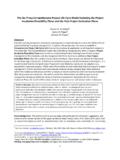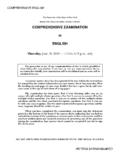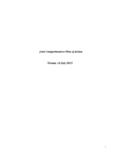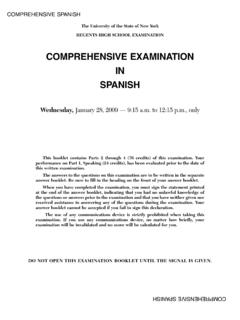Transcription of COMPREHENSIVE KNOWLEDGE MANAGEMENT
1 Copyright KNOWLEDGE Research Institute, Inc. 1999 COMPREHENSIVE KNOWLEDGE MANAGEMENTW orking Paper KRI #1999-4 Revision 2byKARL M. WIIGKNOWLEDGE RESEARCH INSTITUTE, Lake Powell Drive, Arlington, Texas 76016-3517 Phone: (817) 572-6254, Fax: (817) 478-1048E-mail: KNOWLEDGE Research Institute, Inc. 1999 COMPREHENSIVE KNOWLEDGE MANAGEMENTC omprehensive KNOWLEDGE MANAGEMENT (CKM) is undertaken to support enterprise viability andsuccess. It pursues explicit, systematic, and enterprise priority-driven approaches to:1. Identify which Intellectual Capital ( KNOWLEDGE ) needs to be created and maintained including which KNOWLEDGE needs to be available at the PoAs for delivery of desiredcompetitive service paradigms and work products;2.
2 Provide and transform the required KNOWLEDGE and ascertain that it is continuallyrenewed; and3. Ascertain that all available KNOWLEDGE assets (Intellectual Capital) are diligentlyleveraged wherever Govern KNOWLEDGE MANAGEMENT -related processes and relationships by providingenterprise-wide support, infrastructure, and KNOWLEDGE MANAGEMENT (IKM), on the other hand, tends to almost arbitrarily identifyand pursue a KNOWLEDGE -related action, often as an extension of an already occurring activity anincremental improvement on business-as-usual and does not focus on ascertaining that the knowledgeassets are that pursue broad and systematic KNOWLEDGE MANAGEMENT COMPREHENSIVE KM findthat they pursue several sub-practices that in total contribute to the overall success.
3 They are vigilantin their focus on making KNOWLEDGE work effectively as the chief enabler of enterprise success. Thesesub-practices include efforts to:Foster KNOWLEDGE -Supportive Culture Characteristics of the general culture include a safeenvironment, ethical and mutually respectful behavior, minimal politicking, collaboration, anda common focus on delivering quality work without delay , getting the right thing done assoon and with as little fuss as possible! Provide Shared Understanding Develop a broadly shared understanding of the enterprise smission, current direction, and the role of the individual in support of the enterprise and of theindividual s own the KNOWLEDGE MANAGEMENT Practice to Align with Enterprise Direction Practitioners of COMPREHENSIVE KM identify the intended business direction of the enterprise toascertain that the associated KNOWLEDGE -related factors receive appropriate attention and arewell Accelerated Learning Pursue a broad range of KNOWLEDGE transfer activities toascertain that valuable KNOWLEDGE is captured, organized and structured, deployed widely, andused and leveraged.
4 The impetus is on making important KNOWLEDGE flow rapidly, in properquantities, in well-represented and effective ways, and to all valuable the Four Success Factors These factors focus on providing employees with:1. KNOWLEDGE and Resources Professional, craft, and navigational KNOWLEDGE andmetaknowledge, information, and other necessary resources must be made available foremployees to deliver quality work products that satisfy the requirements of the situation and thegeneral service paradigm. Employees must also possess requisite skills and attitudes (that is, COMPREHENSIVE KNOWLEDGE MANAGEMENT KRI WP 1999-4 Copyright KNOWLEDGE Research Institute, Inc. 1999- 2 -personality traits). They must be supported by their ability to think critically and creatively bybeing provided with relevant Opportunities Employees must be placed in situations where they have opportunity usetheir capabilities.
5 Workflows must be organized to take advantage of people s capabilities andto exploit the potentials for innovation and application of Permission Employees must be provided safe environments in which to do their means that they must be given permission to innovate, improvise, and stretch enterprisepolicies and practices beyond predetermined scopes to serve the enterprise s, and thestakeholders , best Motivation Employees must be motivated to act intelligently to do the right thing bybeing provided with understanding and emotional acceptance of how their actions will be ofvalue to stakeholders, the enterprise, and most importantly, to themselves. This factor is mostimportant, and difficult to effectuate.
6 It requires approaches to effective and activecommunication that will be new to Supportive Infrastructure Capabilities Implement new or adapt existingcapabilities to provide needed and effective supports for Effective Governance for the KNOWLEDGE MANAGEMENT Practice Monitor,evaluate, and guide the KM activities and their plans, results, and models that COMPREHENSIVE KM practices often use to structure their activities and prioritiesinclude the Institutional KNOWLEDGE Evolution Cycle indicated in Figure 1 and the PersonalKnowledge Evolution Cycle indicated in Figure Institutional KNOWLEDGE Evolution Cycle considers five stages in the pathway: KNOWLEDGE Development. KNOWLEDGE is developed through learning, innovation, creativity,and importation from outside; KNOWLEDGE Acquisition.
7 KNOWLEDGE is captured and retained for use and further treatment; KNOWLEDGE Refinement. KNOWLEDGE is organized, transformed, or included in written material, KNOWLEDGE bases, and so on to make it available to be useful; KNOWLEDGE Distribution and Deployment. KNOWLEDGE is distributed to Points-of-Action(PoAs) through education, training programs, automated KNOWLEDGE -based systems, expertnetworks, to name a few to people, practices, embedded in technology and procedures, etc.; and KNOWLEDGE Leveraging. KNOWLEDGE is applied or otherwise leveraged. By using (applying) KNOWLEDGE , it becomes the basis for further learning and innovation as explained by KNOWLEDGE MANAGEMENT KRI WP 1999-4 Copyright KNOWLEDGE Research Institute, Inc.
8 1999- 3 - Apply Use and LeverageKnowledgetoAct Effectivelyfor Viability and SuccessDeployKnowledgetoPeople, Practices,Technology, Products, andServicesCapture andStore KnowledgetoReuse, Build, and Leverage Itin Other WaysOrganizeand TransformKnowledgetoMake It BroadlyAvailable andEmbed ItCreateKnowledge:Learn, Innovate,and Research by Using Priorand ImportedKnowledgeFigure 1. The Institutional KNOWLEDGE Evolution Personal KNOWLEDGE Evolution Cycle also has five stages that depict how KNOWLEDGE , as itbecomes better established in a person s mind, migrates from barely perceived notions to be betterunderstood and useful. The five stages are:1. Tacit Subliminal KNOWLEDGE . This KNOWLEDGE is mostly nonconscious and is not wellunderstood.
9 It is often the first glimpse we have of a new KNOWLEDGE is part of the associations and mental models that we often describe as intuition. Other labels: Emerging or Not-Yet-Understood ( Glimpsed ) Knowledge2. Idealistic Vision and Paradigm KNOWLEDGE . Part of this KNOWLEDGE is well known to us andexplicit -- we work consciously with it. Much of it -- our visions and mental models -- is not wellknown, it is tacit, and only accessible nonconsciouslyVery little KNOWLEDGE transfer takes place on this level. Benchmarking as practiced by somecompanies tries to get at it but not very labels: Goal-Setting or Idealistic KNOWLEDGE - KNOWLEDGE WHY COMPREHENSIVE KNOWLEDGE MANAGEMENT KRI WP 1999-4 Copyright KNOWLEDGE Research Institute, Inc.
10 1999- 4 -3. Systematic Schema and Reference Methodology KNOWLEDGE . Our KNOWLEDGE of underlyingsystems, general principles, and problem-solving strategies is, to a large extent, explicit andmostly well known to usThis KNOWLEDGE is part of what we often call deep KNOWLEDGE and we may build a small partof it into KNOWLEDGE -based labels: Systemic KNOWLEDGE - KNOWLEDGE WHAT 4. Pragmatic Decision-Making and Factual KNOWLEDGE . Decision-Making KNOWLEDGE is practicaland mostly explicit. It supports everyday work and decisions, is well known, and is usedconsciouslyMost training takes place on this level. AI-based systems try to incorporate some of labels: Pragmatic KNOWLEDGE - KNOWHOW 5. Automatic Routine Working KNOWLEDGE .










